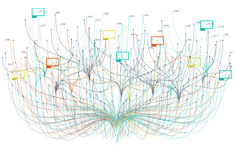Hello and welcome back once again my fellow AI & tech enthusiasts!
Remember the days when we thought digital cameras were the pinnacle of photography innovation? Well, buckle up because we’re about to take a wild ride through the mind-blowing world of AI in consumer tech and media. Trust me, by the end of this post, you’ll be seeing your smartphone camera in a whole new light.
Beam Me Up, Scotty: AI’s Not Just for Trekkies Anymore
Let’s kick things off with a confession: Initially, I used to be a skeptic when it came to AI. I mean, sure, it sounded cool in movies, but in real life? I wasn’t so sure. That all changed a few summers ago when I went on a hiking trip with a good friend.
Picture this (no pun intended): We’re standing at the edge of this breathtaking canyon, golden hour is setting in, and I’m fumbling with my phone, trying to capture the perfect shot. Just as I’m about to give up and settle for a mediocre photo, my friend David whips out his new smartphone and says, “Let me try.”
What happened next blew my mind. The AI in his phone analyzed the scene in real time, suggested a slight angle adjustment, and even recommended waiting a few seconds for a passing bird to enter the frame. The result? A photo that looked like it belonged in National Geographic, not on some amateur’s Instagram.
That’s when it hit me – AI isn’t just changing photography; it’s revolutionizing how we capture and experience the world around us. And it’s not just limited to photos. AI works behind the scenes to enhance every aspect of our digital lives, from the shows we binge-watch to the music we stream.
AI in Photography: More Than Just Making You Look Good (But It Does That Too!)
Now, I know what you’re thinking. ‘AI in photography? Isn’t that just fancy filters?’ Oh, my friend, we’re way past the days of slapping a sepia tone on a picture and calling it art. Let me break it down for you.
Smart Composition: Your Personal Pocket Photographer
Remember that canyon photo I mentioned? That’s just the tip of the iceberg. AI-powered composition tools like ClipDrop and Pixel Perfect are like having a world-class photographer whisper tips in your ear. They can analyze scenes in real-time, suggesting optimal framing, lighting adjustments, and even the best moment to hit that shutter button.
Just last month, I was trying to take a group photo at my niece’s birthday party. Kids were running around, cake was everywhere, and it was chaos. But my phone’s AI came to the rescue, suggesting a slight pan to the left to create a more balanced composition and waiting for that split second when everyone was (miraculously) looking at the camera. The result? A perfect shot that’s now proudly displayed on my sister’s fridge.
Style Transfer: Channel Your Inner Picasso (No Talent Required)
Okay, let’s get a bit artsy for a second. Have you ever looked at a Van Gogh and thought, “Man, I wish my vacation photos looked like that”? Well, guess what? Now they can, with just a tap of your finger!
AI-powered style transfer is like having a team of master artists at your fingertips. With just a tap, you can transform your ordinary snapshots into works of art that would make the greats proud. I recently used this feature on a photo of my dog, turning a simple portrait into a Warhol-esque pop art masterpiece. It’s now the centrepiece of my living room, and yes, I’m that person who has a giant, colourful portrait of their pet on display. No regrets!
But here’s the kicker—this isn’t just about slapping on a filter. The AI analyzes the content of your image, understanding the shapes, colours, and textures, and then reinterprets them in the chosen style. It’s like the AI is channelling the artist’s spirit, creating something truly unique.
Object Removal and Scene Manipulation: Bye-bye, Photo Bombers!
We’ve all been there – the perfect family photo ruined by some random stranger wandering into the background. Or that stunning landscape marred by an unsightly trash can. In the past, fixing these issues required some serious Photoshop skills. But now? AI’s got your back, solving these problems with ease.
I recently put this to the test during my trip to Montreal for a Montreal Canadiens game. I had this fantastic shot of the Bell Centre, but a tour group was right in the foreground. Instead of settling for a subpar photo, I used an AI-powered object removal tool. It didn’t just erase the people; it intelligently filled in the gaps with an accurate scene prediction without them. The result was so seamless that you’d never know there was ever anyone there.
But wait, there’s more! AI isn’t just about removing things; it can also add them. Imagine being able to insert a majestic mountain range into your backyard barbecue shot, with lighting and perspective perfectly matched to the original scene. It’s like having the power to bend reality right in your pocket.
The Wizardry Behind the Curtain: Data Annotation
Now, I know what you’re wondering: “How on earth does AI learn to do all this cool stuff?” Well, my curious friend, let me introduce you to the unsung hero of the AI world: data annotation.
Data annotation is the unsung hero of the AI world. It’s like the gruelling training montage in every sports movie, turning a scrappy underdog (in this case, a bunch of algorithms) into a champion (the AI that makes your photos look amazing).
So, What Exactly is Data Annotation?
Imagine you’re teaching a toddler to recognize different animals. You point to a dog and say ‘dog’ over and over until they get it. Then you move on to cats, birds, and so on. Data annotation works similarly but on a massive scale in AI development.
In AI, we’re “teaching” computer systems to recognize everything from facial features to artistic styles, lighting conditions, and object boundaries. We do this by labeling vast amounts of data—images, videos, and audio—with relevant information.
For example, to train an AI to recognize different dog breeds, you’d need thousands of images of dogs, each carefully labelled with the correct breed. It’s a bit like creating the world’s largest, most detailed flashcard set.
Why Data Annotation Matters (A Lot)
Here’s the thing: the quality of this annotation directly impacts how well the AI performs. Poor annotation leads to unreliable AI, while high-quality annotation results in those “wow” moments when your device seems to read your mind.
I learned this the hard way when I tried using a budget app that claimed to use AI to categorize my expenses. Let’s say it thought my gym membership was “entertainment” and my Netflix subscription was “healthcare.” Not exactly the financial insights I was hoping for!
On the flip side, when data annotation is done right, the results can be mind-blowing. Take voice assistants, for example. They can understand different accents, dialects, and even contexts because of extensive, high-quality data annotation. Someone (or, more likely, many someones) spent countless hours labelling audio samples with not just the words spoken but the intent behind them.
Best Practices for Data Annotation in Consumer Tech & Media
Now that we understand the importance of data annotation, let’s chat about some best practices. These guidelines are crucial whether you’re a tech enthusiast, a budding AI developer, or just someone who wants to understand why your phone is suddenly so smart.
1. Define Clear Annotation Guidelines: The Devil’s in the Details
Imagine you’re putting together a massive jigsaw puzzle, but everyone working on it has a slightly different idea of what the final picture should look like. Madness, right? That’s what happens when you don’t have clear annotation guidelines.
Before diving into annotation, it’s crucial to establish comprehensive guidelines. These should cover:
– Precise definitions of categories and labels (our Data Labelling Services page has a great explanation of how this all works)
– Examples of correct and incorrect annotations
– How to handle edge cases (those tricky situations that don’t quite fit the norm)
Let me give you a real-world example. I recently chatted with a friend who works on AI for a beauty app. She told me about the challenges of annotating facial features for their virtual makeup tool. They had to clearly define what constitutes the boundary of the lips (is it where the colour changes or where the texture changes?), how to handle partially obscured features (like when someone’s hair is covering part of their face), and guidelines for diverse skin tones and facial structures.
Without these detailed guidelines, you will end up with inconsistent data, which could lead to an AI that gives you purple lipstick when you ask for nude!
2. Ensure Diverse and Representative Datasets: Because the Real World Isn’t One-Size-Fits-All
Here’s a hard truth guys and gals: AI is only as good as the data it’s trained on. If your dataset isn’t diverse and representative, your AI won’t be either.
I remember this when I first started using a fitness app (not to be named) with AI-powered pose recognition for yoga. As a not-so-flexible beginner, I found that the app needed help recognizing my awkward attempts at downward dog. Why? Because the training data mostly included images of experienced yogis with perfect form.
To create truly inclusive and effective AI systems, your datasets must reflect the real world’s diversity. In photography applications, this means including images that represent:
– Various skin tones, ages, and ethnicities
– Different lighting conditions and environments
– A wide range of photographic styles and compositions
This ensures that the resulting AI can perform well across a broad spectrum of real-world scenarios. It’s not just about better technology—it’s about creating AI that works for everyone.
3. Implement Rigorous Quality Control: Trust but Verify
Quality control in data annotation isn’t just important – it’s essential. Think of it as the difference between a five-star restaurant and a sketchy food truck. Both might serve food, but only one will leave you feeling confident about what you’re consuming.
Implement a multi-tiered review process:
– Initial annotation by trained annotators
– Peer review by other annotators
– Final review by expert annotators or domain specialists
I once spoke with a data scientist working on an AI project for a major streaming platform. They were annotating emotional content in movies to improve recommendation algorithms. Their process involved:
1. Initial tagging by trained annotators who watched scenes and labelled emotions.
2. A peer review where another annotator would check the labels.
3. A final review by a panel included a psychologist to ensure the emotional labels were accurate and nuanced.
This level of rigour might seem excessive, but it’s what separates good AI from great AI. It’s the difference between a streaming service that keeps suggesting the same type of movies and one that seems to know your taste better than you do.
4. Leverage Technology for Efficiency: Work Smarter, Not Just Harder
While human expertise in data annotation is irreplaceable, technology can significantly boost efficiency. It’s like using a power drill instead of a manual screwdriver – you’ll get the job done faster and with less effort.
Here are some ways to leverage technology in data annotation:
– Use pre-annotation tools to generate initial labels, which human annotators can then refine
– Implement active learning algorithms that prioritize the most informative samples for annotation
– Utilize annotation assistance tools that suggest labels based on context and previous annotations
For example, in annotating video content for the streaming platform I mentioned earlier, AI can pre-tag scenes, characters, and emotions, allowing human annotators to focus on nuanced judgments and edge cases.
As mentioned in a previous blog post entitled “Master Data Annotation for Autonomous Vehicles: A Comprehensive Guide” I heard about a project where AI was used to pre-annotate street scenes for a self-driving car system. The AI could quickly identify common elements like road signs and lane markings, leaving human annotators free to focus on more complex elements like pedestrian behaviour and unusual obstacles. This approach sped up the process and reduced annotator fatigue, leading to higher-quality results.
5. Prioritize Data Privacy and Ethics: With Great Power Comes Great Responsibility
In consumer tech and media, you’re often dealing with sensitive personal data. It’s crucial to prioritize privacy and ethical considerations. Think of it this way: you wouldn’t want your personal photos or viewing habits shared without your permission, right?
Here are some key points to keep in mind:
– Anonymize personal information in images and videos
– Obtain proper consent for using and annotating user-generated content
– Adhere to data protection regulations like GDPR and CCPA
I’m sure you may have heard about a certain also to be unnamed social media app that got into hot water for using user photos to train their AI without explicit consent. The backlash was swift and severe. Don’t let this happen to you or your company!
When annotating user photos for AI features, ensure that any identifiable information is obscured and that you have explicit user consent for using their images in AI training. It’s not just about avoiding legal troubles – it’s about building trust with your users.
Buckle Up, Things Are Starting To Get Magical!
As we look to the horizon, the possibilities seem endless. And let me tell you, the future looks bright (and incredibly high-resolution)!
Imagine AI that can:
– Generate entire photoshoots based on a simple text description. “I want a series of photos that capture the essence of a cozy winter evening in a mountain cabin.” Boom! Your AI delivers a set of images that look like a professional photographer shot them.
– Create personalized movie trailers tailored to individual viewing preferences. Love action scenes but hate spoilers? Your AI-generated trailer will get your heart pumping without giving away the plot.
– Automatically edit and score home videos to professional standards. That shaky footage of your kid’s school play? Transformed into a cinematic masterpiece that would make Steven Spielberg proud.
These aren’t just pipe dreams – they’re the logical next steps in the AI revolution we’re witnessing. And at the heart of it all? High-quality, meticulously annotated data.
Your Role in the AI Revolution Happening Right Now!
You might be thinking, “This all sounds amazing, but what does it have to do with me? I may or may not be a data scientist or an AI engineer.” Well, here’s the thing: as a consumer of tech and media, you’re an integral part of this AI revolution.
Every photo you take, video you watch, and interaction with your devices contributes to the vast pool of data shaping the future of AI. You’re not just a passive consumer—you’re an active participant in this technological evolution.
So the next time you’re marvelling at how your phone managed to capture the perfect shot in challenging lighting or how a streaming service recommended your new favourite show, remember the intricate dance of AI, data annotation, and human creativity that made it possible.
And who knows? Maybe the next great leap in AI will be inspired by how you use your devices. So keep snapping those photos, binge-watching those shows, and exploring new technologies. You’re not just using the future – you’re helping to create it.
The future of consumer tech and media is being written right now, one carefully annotated data point at a time. And it promises to be more creative, more personalized, and more magical than we ever imagined. So, are you ready to be part of this exciting journey? I know I am! If you have any questions, don’t hesitate to reach out to us as were always happy to chat with fellow AI and tech enthusiast’s! … And if you’re looking for data annotation services, feel free to browse our Data Annotation Services Page to quickly help with your particular needs.
Remember, in this AI-powered world, the only limit is our imagination. And from where I’m standing, the view looks pretty spectacular. Now, if you’ll excuse me, I have some much-needed AI-enhanced selfies to fix!










